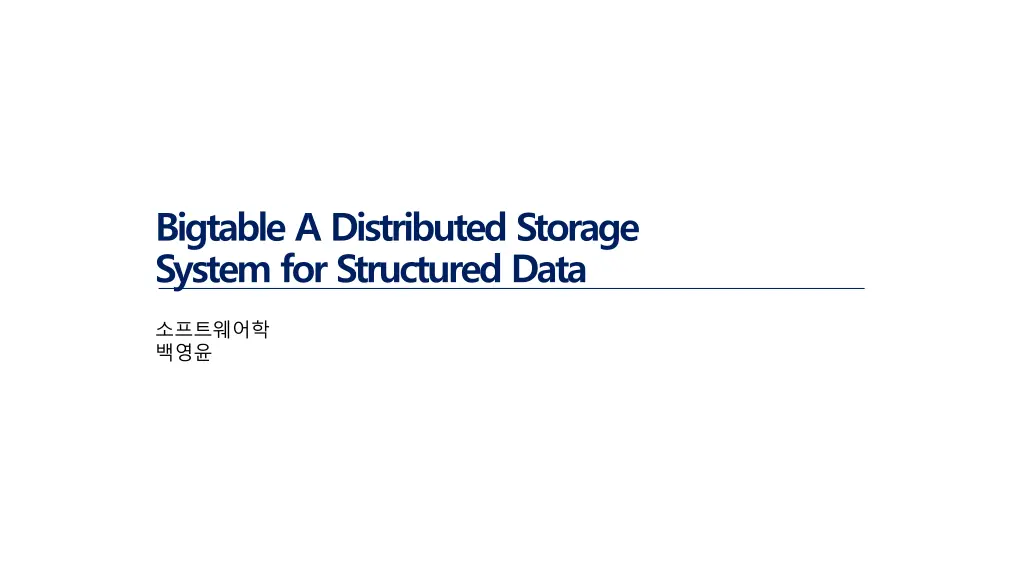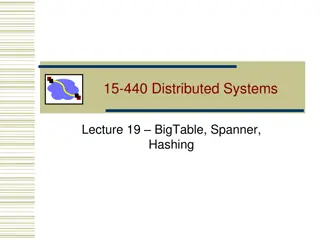
Understanding Bigtable: A Distributed Storage System for Structured Data
Discover the power of Bigtable, a distributed storage system designed for structured data. Learn about its data model, building blocks, implementation, refinements, performance evaluation, and real-world applications. Explore how Bigtable organizes data using row keys, column families, and timestamps, and how it maintains data in lexicographic order. Dive into the details of its column family contents, building blocks like Chubby and GFS integration, as well as implementation aspects.
Download Presentation

Please find below an Image/Link to download the presentation.
The content on the website is provided AS IS for your information and personal use only. It may not be sold, licensed, or shared on other websites without obtaining consent from the author. If you encounter any issues during the download, it is possible that the publisher has removed the file from their server.
You are allowed to download the files provided on this website for personal or commercial use, subject to the condition that they are used lawfully. All files are the property of their respective owners.
The content on the website is provided AS IS for your information and personal use only. It may not be sold, licensed, or shared on other websites without obtaining consent from the author.
E N D
Presentation Transcript
Bigtable A Distributed Storage System for Structured Data
INDEX What is the Bigtable? Data Model Building Blocks Implementation Refinements Performance Evaluation Real Applications
What is the Bigtable? Big table? NO!!! Bigtable!
What is the Bigtable Bigtable Spares, distributed, persistent multi dimensional sorted map. Map is indexed by a row key, column key, and a time stamp Each value in the map is an uninterpreted array of bytes. Row Row key Column Families Time stamp
Data Model Rows The row keys in a table are arbitrary string Bigtable maintains data in lexicographic order by row key. Each value in the map is an uninterpreted array of bytes. Column Families Column keys are grouped into sets called column families A column key is named using the following syntax family:qulifier Timestamps Multiple versions are indexed by timestamp.
Data Model Column Family contents: Column Family anchor: Row key Time Stamp Column anchor:my.l ook.ca anchor:cnnsi .com Column key Row key com.cnn.www t3 <html> Row Structured data t5 <html> com.cnn.www <html> t6 com.cnn.www CNN t8 com.cnn.www Time stamp Column Family com.cnn.www t9 CNN.com
Building Blocks Master Chubby Master Overall integration GFS Tablet Server tablet management Tablet Server Tablet Server Commit Log Tablet Server memtable SSTable SSTable SSTable Client Data read & write index tablet index Client index tablet memtable SSTable Table for read-only searches Tablet is composed of multiple SSTables tablet memtable Chubby Highly-available and persistent distributed lock service
Building Blocks Chubby Cell Chubby File System Lock Service Event notification Tablet Server Replica Tablet Server Replica Client Tablet Server Master Tablet Server Client Replica Tablet Server Replica
Implementation com.cnn.www t3 <html> <html> t5 com.cnn.www increase <html> t6 com.cnn.www CNN t8 com.cnn.www t9 com.cnn.www CNN.com increase tablet tablet com.cnn.www t3 <html> CNN t8 com.cnn.www t5 <html> com.cnn.www t9 com.cnn.www CNN.com <html> t6 com.cnn.www
Implementation Tablet Location Three-level hierarchy analogous to that of a B+tree Root tablet - Metadata tablet management, Search starting point METADATA tablet - User Tablet Management, User Tablet - Data Table 11 Table 1 Table 11 Table 12 Economy.com news news Table 12 culture Asia.com culture Table 2 Chubby Table 1 com.cnn.www . com.cnn.imag e.www Table 2 block data Root Tablet data User Tablet Metadata Tablet
Implementation Tablet Assignment Each tablet is assigned to one tablet server at a time tablet server malfunction - Assign a tablet to another server Master Chubby GFS Tablet Server Tablet Server Tablet Server memtable tablet tablet memtable tablet memtable
Implementation Tablet Serving Recently committed ones are stored in memory in a sorted buffer Older updates are stored in a sequence of SSTables Master Chubby GFS Tablet Server Tablet Server Commit Log Tablet Server memtable SSTable SSTable SSTable index tablet index index tablet memtable tablet memtable
Implementation Client Tablet Serving GFS Write 1. Create Log Tablet Server Commit Log - Add what to write to the commit log - Update Memtable - Passing results to the client 2. Writing Read memtable - Search key in Memtable - If there is recent data, return to client - If present in SSTable, receive from GFS and return memtable 1. Check memtable SSTable Tablet Server 2. reading Client
Implementation Client Compaction GFS Minor Compaction - When the Memtable grows, it is recorded in a new SSTable. - Only recent Memtable updates are recorded - Deleting the contents of the Commit log Tablet Server Commit Log Minor Compaction SSTable memtable Major Compaction - Reading efficiency decreases as SStable increases - Disk waste - Working to bring SSTable together memtable SSTable Tablet Server SSTable SSTable SSTable Client Major Compaction
Refinements Locality Groups Column family likely to be used at the same time - Group by locality groups Data Compression Automatic compression and decompression by locality group Cash for read performance Data is present in the memory of the tablet server Reduced communication with GFS Bloom filters
Refinements Commit-log implementation Large write batch processing Speeding up tablet recovery reducing the amount of uncompacted state in the tablet server's commit log Exploiting immutability
Performance Evaluation Bigtable cluster with N tablet servers The table shows the number of operations per second per tablet server The graph shows the aggregate number of operations per second








